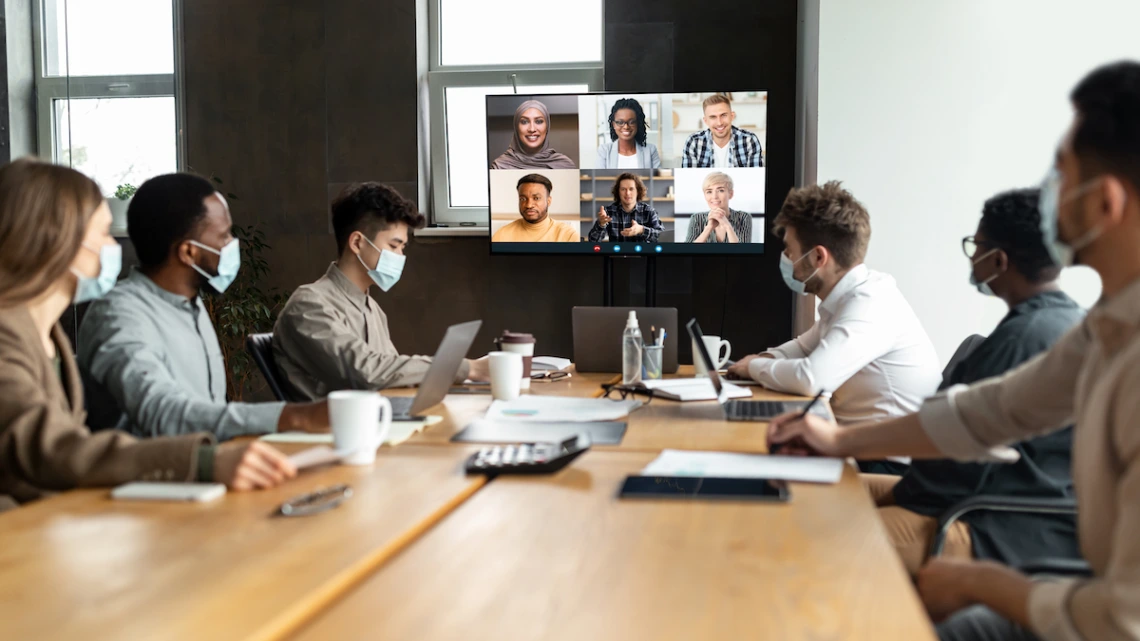Check out these technology and facilitation tips for more inclusive and effective hybrid meetings

Hybrid meetings can be a challenge, leaving virtual attendees feeling ignored. But they can be successful with some planning and flexibility to make sure all participants have equal opportunity to contribute.

Allison Gabriel, University Distinguished Scholar in the Eller College of Management and the McClelland Professor of Management and Organizations
Virtual and hybrid meetings are here to stay, along with the challenges they bring, says Allison Gabriel, an expert in employee well-being and emotions at work.
"These virtual meetings were first started to bring people together, but the hybrid element of it can actually drive people apart," says Gabriel, University Distinguished Scholar in the Eller College of Management and the McClelland Professor of Management and Organizations. "When you have a big group of people in person and a smaller group of people joining virtually on Zoom, it's easy for them to feel excluded."
Gabriel, who has published research on Zoom fatigue, says virtual attendees can feel like they are watching a meeting, instead of being a part of it.
The challenges can be especially difficult for those who are introverted, Gabriel says.
"Introverted individuals often get conflated with people who aren't engaged, because they are not likely to be the type of person who jumps right into discussions," she said. "They often do deep observing and thinking ahead of time about their reactions."
There are ways that meeting facilitators can combat the sense of "otherness" felt by people who attend meetings virtually, regardless of whether they are introverted or extroverted.
One way is to structure the meeting so that virtual participants can be engaged. That can include starting the meeting by seeking contributions from online attendees. Another is to make sure there are pauses in the meeting that create space for participants to speak.
The chat function can be especially helpful by allowing introverted attendees to contribute without being put on the spot, Gabriel said. Meeting facilitators might also consider allowing invitees to submit their contributions ahead of time or to give their feedback in a one-on-one setting after the meeting.
Another suggestion: Designate someone to be the point of contact for virtual attendees. This person will monitor messages and questions in the chat and let the facilitators know when somebody attending virtually has indicated they want to speak.
"It's important to have a designated manager of that communications process," she said.
Gabriel's research also has examined the role of the camera for virtual meeting participants. It's important to give employees the autonomy to decide whether to have their cameras on and drop the assumption that people who have their cameras off are less engaged, she says.
"People's lives are still very messy, so giving people the ability to stay flexible through camera use will allow them to thrive in whatever non-work situation they are operating in."
Overall, she says, it's important for meeting facilitators to be adaptable and willing to make changes as they learn what works for their team.
"Remember, we've been doing in-person meetings for 100 years," Gabriel said. "We've only been doing virtual and hybrid meetings in this capacity and frequency for two."
Beyond intentional efforts to engage virtual participants, meeting facilitators can also use technology and Zoom functions to make hybrid meetings more inclusive.
Below is a list of tips curated from experts at University Information Technology Services.
Make a plan. Planning ahead is important for setting up a successful hybrid meeting. Knowing some of the logistical arrangements in advance – such as number of in-person and remote attendees and the setup of the physical space – and thinking through ways to engage your audience can help you hold successful hybrid meetings.
Know your space. Smaller rooms will accommodate video collaboration better than large rooms generally, but this will depend on the equipment available in the space. If a large space is outfitted with microphones for in-person attendees, then a large space will work for virtual meetings. If there is a whole room camera available, turn on the room video feed so remote participants can actively view when in-room participants are speaking. One helpful resource is the Room Layouts page on the Classroom Technology Services website.
Appoint a moderator. When you're confident that someone is answering questions or providing video or sound adjustments for your online attendees, you can focus on the delivery of your content.
Be accessible. A meeting host can enable live transcription for any Zoom meeting. This option is located in the CC button of the Zoom meeting toolbar. While live transcription is helpful, it is not always completely accurate. If you are holding an event open to others outside the University, please consider making accommodations through the Disability Resource Center to offer live captioning.
Engage your audience. Take advantage of the Zoom breakout rooms function for workshops and connecting with smaller groups attending a larger meeting. The meeting host can randomly assign or manually assign participants to breakout rooms or allow them to choose their own.
Can you hear me now? There are several things you can do to get the best audio during a Zoom meeting.
- If in-person attendees are joining the meeting from laptops or other devices, ask them to enter the meeting without audio or select "leave computer audio." This ensures the audio heard by remote participants is limited to the host's microphone and room speakers.
- Activate the "mute participants on entry" function prior to the meeting start, which will minimize inadvertent interruptions.
To avoid unwanted microphone feedback, consider purchasing a headset, or headphones with a microphone. Microphones should be placed to capture the largest possible area. If you have a specialized use case, such as a panel presentation, the microphone can be placed directly in front of the person speaking.
Planning for a crowd. For large meetings with a hybrid component, reach out to your unit's IT support group to discuss the plan, equipment availability, and any specific guidance they may have.
Allow in-person and remote attendees to see each other when possible. If you can, use the presentation computer to show the in-person attendees so that those joining remotely can see them. In addition, show remote participants on an in-room display.
Prepare the video capturing device in advance. If possible, use a designated webcam rather than a laptop camera. A webcam should be placed to capture as many speaking participants as possible while preserving image quality. Be cautious of FERPA violations when setting your camera location. The combination of the individual's image and the course title represents a violation. If you have concerns relating to FERPA guidelines, consult University resources for guidance, including the Office of the Registrar website, which has a FERPA FAQ and a FERPA Compliance page.
Preserve content that is shared in the chat. Participants often share valuable information in the chat that may be valuable to your attendees after the meeting ends. Pulling the chat file and sending it to participants will be appreciated. It is worthwhile to turn on the meeting chat auto-save function in your Zoom settings. With this function enabled, a chat file will automatically be available to all attendees, saving the host from having to send it out.
Wait to share files. Files loaded into the chat is available only to those who have already joined the meeting. Those who join later will not see the files and therefore won't be able to access them from the chat. If the participants need specific files or other materials, it's better to send all of that content to them before or after the session.
In large meetings, consider turning chat off during the presentation portion and then enable it after the speakers have finished. The chat options available to the host are: turn off for all users; allow participants to chat with host and co-host only; allow participants to post messages to the whole group; and allow participants to post messages to the whole group and to chat privately with any other participant. Consider which setting is the most suitable for your session.

